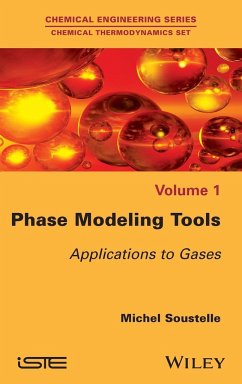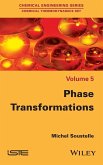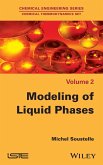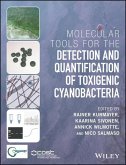- Gebundenes Buch
- Merkliste
- Auf die Merkliste
- Bewerten Bewerten
- Teilen
- Produkt teilen
- Produkterinnerung
- Produkterinnerung
This book is part of a set of books which offers advanced students successive characterization tool phases, the study of all types of phase (liquid, gas and solid, pure or multi-component), process engineering, chemical and electrochemical equilibria, and the properties of surfaces and phases of small sizes. Macroscopic and microscopic models are in turn covered with a constant correlation between the two scales. Particular attention has been given to the rigor of mathematical developments.
Andere Kunden interessierten sich auch für
![Statistical Tools for the Comprehensive Practice of Industrial Hygiene and Environmental Health Sciences Statistical Tools for the Comprehensive Practice of Industrial Hygiene and Environmental Health Sciences]() David L JohnsonStatistical Tools for the Comprehensive Practice of Industrial Hygiene and Environmental Health Sciences121,99 €
David L JohnsonStatistical Tools for the Comprehensive Practice of Industrial Hygiene and Environmental Health Sciences121,99 €![Decision-Making Tools to Support Innovation Decision-Making Tools to Support Innovation]() Decision-Making Tools to Support Innovation173,99 €
Decision-Making Tools to Support Innovation173,99 €![Phase Transformations Phase Transformations]() Michel SoustellePhase Transformations187,99 €
Michel SoustellePhase Transformations187,99 €![Modeling of Liquid Phases Modeling of Liquid Phases]() Michel SoustelleModeling of Liquid Phases187,99 €
Michel SoustelleModeling of Liquid Phases187,99 €![Marine Toxins as Research Tools Marine Toxins as Research Tools]() Nobuhiro Fusetani / William Kem (eds.)Marine Toxins as Research Tools154,99 €
Nobuhiro Fusetani / William Kem (eds.)Marine Toxins as Research Tools154,99 €![Molecular Tools for the Detection and Quantification of Toxigenic Cyanobacteria Molecular Tools for the Detection and Quantification of Toxigenic Cyanobacteria]() Molecular Tools for the Detection and Quantification of Toxigenic Cyanobacteria171,99 €
Molecular Tools for the Detection and Quantification of Toxigenic Cyanobacteria171,99 €![Smart Tools for Smart Applications Smart Tools for Smart Applications]() Smart Tools for Smart Applications79,99 €
Smart Tools for Smart Applications79,99 €-
-
-
This book is part of a set of books which offers advanced students successive characterization tool phases, the study of all types of phase (liquid, gas and solid, pure or multi-component), process engineering, chemical and electrochemical equilibria, and the properties of surfaces and phases of small sizes. Macroscopic and microscopic models are in turn covered with a constant correlation between the two scales. Particular attention has been given to the rigor of mathematical developments.
Hinweis: Dieser Artikel kann nur an eine deutsche Lieferadresse ausgeliefert werden.
Hinweis: Dieser Artikel kann nur an eine deutsche Lieferadresse ausgeliefert werden.
Produktdetails
- Produktdetails
- Verlag: Wiley
- Seitenzahl: 300
- Erscheinungstermin: 31. August 2015
- Englisch
- Abmessung: 240mm x 161mm x 21mm
- Gewicht: 619g
- ISBN-13: 9781848218642
- ISBN-10: 1848218648
- Artikelnr.: 42961746
- Herstellerkennzeichnung
- Libri GmbH
- Europaallee 1
- 36244 Bad Hersfeld
- gpsr@libri.de
- Verlag: Wiley
- Seitenzahl: 300
- Erscheinungstermin: 31. August 2015
- Englisch
- Abmessung: 240mm x 161mm x 21mm
- Gewicht: 619g
- ISBN-13: 9781848218642
- ISBN-10: 1848218648
- Artikelnr.: 42961746
- Herstellerkennzeichnung
- Libri GmbH
- Europaallee 1
- 36244 Bad Hersfeld
- gpsr@libri.de
Michel SOUSTELLE is a chemical engineer and Emeritus Professor at Ecole des Mines de Saint-Etienne in France. He taught chemical kinetics from postgraduate to Master degree level while also carrying out research in this topic.
PREFACE xiii
NOTATIONS xvii
SYMBOLS xix
CHAPTER 1. THERMODYNAMIC FUNCTIONS AND VARIABLES 1
1.1. State variables and characteristic functions of a phase 2
1.1.1. Intensive and extensive conjugate variables 2
1.1.2. Variations in internal energy during a transformation 3
1.1.3 Characteristic function associated with a canonical set of variables
5
1.2. Partial molar parameters 7
1.2.1. Definition 7
1.2.2. Properties of partial molar variables 8
1.3. Chemical potential and generalized chemical potentials 8
1.3.1. Chemical potential and partial molar free enthalpy 8
1.3.2. Definition of generalized chemical potential 9
1.3.3. Variations in the chemical potential and generalized chemical
potential with variables 10
1.3.4. Gibbs-Duhem relation 10
1.3.5. Generalized Helmholtz relations 11
1.3.6. Chemical system associated with the general system 12
1.4. The two modeling scales 14
CHAPTER 2. MACROSCOPIC MODELING OF A PHASE 15
2.1. Thermodynamic coefficients and characteristic matrices 15
2.1.1. Thermodynamic coefficients and characteristic matrix associated with
the internal energy 15
2.1.2. Symmetry of the characteristic matrix 17
2.1.3. The thermodynamic coefficients needed and required to
thermodynamically define the phase 17
2.1.4. Choosing other variables: thermodynamic coefficients and
characteristic matrix associated with a characteristic function 19
2.1.5. Change in variable from one characteristic matrix to another 22
2.1.6. Relations between thermodynamic coefficients and secondary
derivatives of the characteristic function 26
2.1.7. Examples of thermodynamic coefficients: calorimetric coefficients 27
2.2. Partial molar variables and thermodynamic coefficients 27
2.3. Common variables and thermodynamic coefficients 28
2.3.1. State equation 29
2.3.2. Expansion coefficients 30
2.3.3. Molar heat capacities 32
2.3.4. Young's Modulus 34
2.3.5. Electric permittivity 34
2.3.6. Volumic and area densities of electric charge 34
2.4. Thermodynamic charts: justification of different types 35
2.4.1. Representation of a variable as a function of its conjugate 35
2.4.2. Representation of a characteristic function as a function of one of
its natural variables 38
2.5. Stability of phases 39
2.5.1. Case of ensemble E0 of extensive variables 40
2.5.2. Coefficients associated with ensemble En 43
2.5.3. Case of other ensembles of variables 44
2.5.4. Conclusion: stability conditions of a phase in terms of
thermodynamic coefficients 46
2.5.5. Example - applying stability conditions 46
2.6. Consistency of thermodynamic data 48
2.7. Conclusion on the macroscopic modeling of phases 49
CHAPTER 3. MULTI-COMPOUND PHASES - SOLUTIONS 51
3.1. Variables attached to solutions 51
3.1.1. Characterizing a solution 52
3.1.2. Composition of a solution 53
3.1.3. Peculiar variables and mixing variables 54
3.2. Recap of ideal solutions 57
3.2.1. Thermodynamic definition 57
3.2.2. Molar Gibbs energy of mixing of an ideal solution 57
3.2.3. Molar enthalpy of mixing of the ideal solution 57
3.2.4. Molar entropy of mixing of the ideal solution 58
3.2.5. Molar volume of mixing 58
3.2.6. Molar heat capacity of ideal solution: Kopp's law 58
3.3. Characterization imperfection of a real solution 59
3.3.1. Lewis activity coefficients 60
3.3.2. Characterizing the imperfection of a real solution by the excess
Gibbs energy 71
3.3.3. Other ways to measure the imperfection of a solution 74
3.4. Activity of a component in any solution: Raoult's and Henry's laws 76
3.5. Ionic solutions 77
3.5.1. Chemical potential of an ion 78
3.5.2. Relation between the activities of ions and the overall activity of
solutes 80
3.5.3. Mean concentration and mean ionic activity coefficient 80
3.5.4. Obtaining the activity coefficient of an individual ion 82
3.5.5. Ionic strength 82
3.6. Curves of molar variables as a function of the composition in binary
systems of a solution with two components 83
CHAPTER 4. STATISTICS OF OBJECT COLLECTIONS 87
4.1. The need to statistically process a system 87
4.1.1. Collections, system description - Stirling's approximation 87
4.1.2. Statistical description hypothesis 88
4.1.3. The Boltzmann principle 89
4.2. Statistical effects of distinguishable non-quantum elements 89
4.2.1. Distribution law 90
4.2.2. Calculation of 91
4.2.3. Determining coefficient 92
4.2.4. Energy input to a system 95
4.2.5. The Boltzmann principle for entropy 96
4.3. The quantum description and space of phases 97
4.3.1. Wave functions and energy levels 97
4.3.2. Space of phases: discernibility of objects and states 98
4.3.3. Localization and non-localization of objects 98
4.4. Statistical effect of localized quantum objects 99
4.5. Collections of non-localized quantum objects 100
4.5.1. Eigen symmetrical and antisymmetric functions of non-localized
objects 101
4.5.2. Statistics of non-localized elements with symmetrical wave functions
103
4.5.3. Statistics of non-localized elements with an asymmetric function
105
4.5.4. Classical limiting case 107
4.6. Systems composed of different particles without interactions 107
4.7. Unicity of coefficient 108
4.8. Determining coefficient in quantum statistics 110
CHAPTER 5. CANONICAL ENSEMBLES AND THERMODYNAMIC FUNCTIONS 113
5.1. An ensemble 113
5.2. Canonical ensemble 114
5.2.1. Description of a canonical ensemble 114
5.2.2. Law of distribution in a canonical ensemble 115
5.2.3. Canonical partition function 116
5.3. Molecular partition functions and canonical partition functions 117
5.3.1. Canonical partition functions for ensembles of discernable
molecules 117
5.3.2. Canonical partition functions of indiscernible molecules 118
5.4. Thermodynamic functions and the canonical partition function 120
5.4.1. Expression of internal energy 120
5.4.2. Entropy and canonical partition functions 121
5.4.3. Expressing other thermodynamic functions and thermodynamic
coefficients in the canonical ensemble 123
5.5. Absolute activity of a constituent 125
5.6. Other ensembles of systems and associated characteristic functions
127
CHAPTER 6. MOLECULAR PARTITION FUNCTIONS 131
6.1. Definition of the molecular partition function 131
6.2. Decomposition of the molecular partition function into partial
partition functions 131
6.3. Energy level and thermal agitation 133
6.4. Translational partition functions 134
6.4.1. Translational partition function with the only constraint being the
recipient 135
6.4.2. Translational partition function with the constraint being a
potential centered and the container walls 137
6.5. Maxwell distribution laws 139
6.5.1. Distribution of ideal gas molecules in volume 139
6.5.2. Distribution of ideal gas molecules in velocity 140
6.6. Internal partition functions 142
6.6.1. Vibrational partition function 142
6.6.2. Rotational partition function 144
6.6.3. Nuclear partition function and correction of symmetry due to nuclear
spin 146
6.6.4. Electronic partition function 149
6.7. Partition function of an ideal gas 149
6.8. Average energy and equipartition of energy 150
6.8.1. Mean translational energy 151
6.8.2. Mean rotational energy 152
6.8.3. Mean vibrational energy 152
6.9. Translational partition function and quantum mechanics 153
6.10. Interactions between species 155
6.10.1. Interactions between charged particles 155
6.10.2. Interaction energy between two neutral molecules 156
6.11. Equilibrium constants and molecular partition functions 161
6.11.1. Gaseous phase homogeneous equilibria 162
6.11.2. Liquid phase homogeneous equilibria 164
6.11.3. Solid phase homogenous equilibria 166
6.12. Conclusion on the macroscopic modeling of phases 167
CHAPTER 7. PURE REAL GASES 169
7.1. The three states of the pure compound: critical point 169
7.2. Standard state of a molecular substance 170
7.3. Real gas - macroscopic description 171
7.3.1. Pure gas diagram (P-V) 171
7.3.2. "Cubic" state equations 172
7.3.3. Other state equations 177
7.3.4. The theorem of corresponding states and the generalized
compressibility chart 180
7.3.5. Molar Gibbs energy or chemical potential of a real gas 182
7.3.6. Fugacity of a real gas 183
7.3.7. Heat capacities of gases 186
7.4. Microscopic description of a real gas 188
7.4.1. Canonical partition function of a fluid 188
7.4.2. Helmholtz energy and development of the virial 195
7.4.3. Forms of the second coefficient of the virial 197
7.4.4. Macroscopic state equations and microscopic description 202
7.4.5. Chemical potential and fugacity of a real gas 203
7.4.6. Conclusion on microscopic modeling of a real gas 204
7.5. Microscopic approach of the heat capacity of gases 206
7.5.1. Classical theorem from the equipartition of energy 207
7.5.2. Quantum theorem of heat capacity at constant volume 208
CHAPTER 8. GAS MIXTURES 213
8.1. Macroscopic modeling of gas mixtures 213
8.1.1. Perfect solutions of perfect gases 213
8.1.2. Mixture of real gases 215
8.2. Characterizing gas mixtures 217
8.2.1. Method of the state equations of gas mixtures 218
8.2.2. The Beattie-Bridgeman state equation 218
8.2.3. Calculating the compressibility coefficient of a mixture 222
8.2.4. Method using activity coefficients of solutions 225
8.3. Determining activity coefficients of a solution from an equation of
state 225
8.3.1. Methodology 226
8.3.2. Studying solutions using the PSRK method 227
8.3.3. VTPR Model 230
8.3.4. VGTPR Model 233
APPENDICES 237
APPENDIX 1 239
APPENDIX 2 243
APPENDIX 3 245
APPENDIX 4 253
APPENDIX 5 257
BIBLIOGRAPHY 261
INDEX 265
NOTATIONS xvii
SYMBOLS xix
CHAPTER 1. THERMODYNAMIC FUNCTIONS AND VARIABLES 1
1.1. State variables and characteristic functions of a phase 2
1.1.1. Intensive and extensive conjugate variables 2
1.1.2. Variations in internal energy during a transformation 3
1.1.3 Characteristic function associated with a canonical set of variables
5
1.2. Partial molar parameters 7
1.2.1. Definition 7
1.2.2. Properties of partial molar variables 8
1.3. Chemical potential and generalized chemical potentials 8
1.3.1. Chemical potential and partial molar free enthalpy 8
1.3.2. Definition of generalized chemical potential 9
1.3.3. Variations in the chemical potential and generalized chemical
potential with variables 10
1.3.4. Gibbs-Duhem relation 10
1.3.5. Generalized Helmholtz relations 11
1.3.6. Chemical system associated with the general system 12
1.4. The two modeling scales 14
CHAPTER 2. MACROSCOPIC MODELING OF A PHASE 15
2.1. Thermodynamic coefficients and characteristic matrices 15
2.1.1. Thermodynamic coefficients and characteristic matrix associated with
the internal energy 15
2.1.2. Symmetry of the characteristic matrix 17
2.1.3. The thermodynamic coefficients needed and required to
thermodynamically define the phase 17
2.1.4. Choosing other variables: thermodynamic coefficients and
characteristic matrix associated with a characteristic function 19
2.1.5. Change in variable from one characteristic matrix to another 22
2.1.6. Relations between thermodynamic coefficients and secondary
derivatives of the characteristic function 26
2.1.7. Examples of thermodynamic coefficients: calorimetric coefficients 27
2.2. Partial molar variables and thermodynamic coefficients 27
2.3. Common variables and thermodynamic coefficients 28
2.3.1. State equation 29
2.3.2. Expansion coefficients 30
2.3.3. Molar heat capacities 32
2.3.4. Young's Modulus 34
2.3.5. Electric permittivity 34
2.3.6. Volumic and area densities of electric charge 34
2.4. Thermodynamic charts: justification of different types 35
2.4.1. Representation of a variable as a function of its conjugate 35
2.4.2. Representation of a characteristic function as a function of one of
its natural variables 38
2.5. Stability of phases 39
2.5.1. Case of ensemble E0 of extensive variables 40
2.5.2. Coefficients associated with ensemble En 43
2.5.3. Case of other ensembles of variables 44
2.5.4. Conclusion: stability conditions of a phase in terms of
thermodynamic coefficients 46
2.5.5. Example - applying stability conditions 46
2.6. Consistency of thermodynamic data 48
2.7. Conclusion on the macroscopic modeling of phases 49
CHAPTER 3. MULTI-COMPOUND PHASES - SOLUTIONS 51
3.1. Variables attached to solutions 51
3.1.1. Characterizing a solution 52
3.1.2. Composition of a solution 53
3.1.3. Peculiar variables and mixing variables 54
3.2. Recap of ideal solutions 57
3.2.1. Thermodynamic definition 57
3.2.2. Molar Gibbs energy of mixing of an ideal solution 57
3.2.3. Molar enthalpy of mixing of the ideal solution 57
3.2.4. Molar entropy of mixing of the ideal solution 58
3.2.5. Molar volume of mixing 58
3.2.6. Molar heat capacity of ideal solution: Kopp's law 58
3.3. Characterization imperfection of a real solution 59
3.3.1. Lewis activity coefficients 60
3.3.2. Characterizing the imperfection of a real solution by the excess
Gibbs energy 71
3.3.3. Other ways to measure the imperfection of a solution 74
3.4. Activity of a component in any solution: Raoult's and Henry's laws 76
3.5. Ionic solutions 77
3.5.1. Chemical potential of an ion 78
3.5.2. Relation between the activities of ions and the overall activity of
solutes 80
3.5.3. Mean concentration and mean ionic activity coefficient 80
3.5.4. Obtaining the activity coefficient of an individual ion 82
3.5.5. Ionic strength 82
3.6. Curves of molar variables as a function of the composition in binary
systems of a solution with two components 83
CHAPTER 4. STATISTICS OF OBJECT COLLECTIONS 87
4.1. The need to statistically process a system 87
4.1.1. Collections, system description - Stirling's approximation 87
4.1.2. Statistical description hypothesis 88
4.1.3. The Boltzmann principle 89
4.2. Statistical effects of distinguishable non-quantum elements 89
4.2.1. Distribution law 90
4.2.2. Calculation of 91
4.2.3. Determining coefficient 92
4.2.4. Energy input to a system 95
4.2.5. The Boltzmann principle for entropy 96
4.3. The quantum description and space of phases 97
4.3.1. Wave functions and energy levels 97
4.3.2. Space of phases: discernibility of objects and states 98
4.3.3. Localization and non-localization of objects 98
4.4. Statistical effect of localized quantum objects 99
4.5. Collections of non-localized quantum objects 100
4.5.1. Eigen symmetrical and antisymmetric functions of non-localized
objects 101
4.5.2. Statistics of non-localized elements with symmetrical wave functions
103
4.5.3. Statistics of non-localized elements with an asymmetric function
105
4.5.4. Classical limiting case 107
4.6. Systems composed of different particles without interactions 107
4.7. Unicity of coefficient 108
4.8. Determining coefficient in quantum statistics 110
CHAPTER 5. CANONICAL ENSEMBLES AND THERMODYNAMIC FUNCTIONS 113
5.1. An ensemble 113
5.2. Canonical ensemble 114
5.2.1. Description of a canonical ensemble 114
5.2.2. Law of distribution in a canonical ensemble 115
5.2.3. Canonical partition function 116
5.3. Molecular partition functions and canonical partition functions 117
5.3.1. Canonical partition functions for ensembles of discernable
molecules 117
5.3.2. Canonical partition functions of indiscernible molecules 118
5.4. Thermodynamic functions and the canonical partition function 120
5.4.1. Expression of internal energy 120
5.4.2. Entropy and canonical partition functions 121
5.4.3. Expressing other thermodynamic functions and thermodynamic
coefficients in the canonical ensemble 123
5.5. Absolute activity of a constituent 125
5.6. Other ensembles of systems and associated characteristic functions
127
CHAPTER 6. MOLECULAR PARTITION FUNCTIONS 131
6.1. Definition of the molecular partition function 131
6.2. Decomposition of the molecular partition function into partial
partition functions 131
6.3. Energy level and thermal agitation 133
6.4. Translational partition functions 134
6.4.1. Translational partition function with the only constraint being the
recipient 135
6.4.2. Translational partition function with the constraint being a
potential centered and the container walls 137
6.5. Maxwell distribution laws 139
6.5.1. Distribution of ideal gas molecules in volume 139
6.5.2. Distribution of ideal gas molecules in velocity 140
6.6. Internal partition functions 142
6.6.1. Vibrational partition function 142
6.6.2. Rotational partition function 144
6.6.3. Nuclear partition function and correction of symmetry due to nuclear
spin 146
6.6.4. Electronic partition function 149
6.7. Partition function of an ideal gas 149
6.8. Average energy and equipartition of energy 150
6.8.1. Mean translational energy 151
6.8.2. Mean rotational energy 152
6.8.3. Mean vibrational energy 152
6.9. Translational partition function and quantum mechanics 153
6.10. Interactions between species 155
6.10.1. Interactions between charged particles 155
6.10.2. Interaction energy between two neutral molecules 156
6.11. Equilibrium constants and molecular partition functions 161
6.11.1. Gaseous phase homogeneous equilibria 162
6.11.2. Liquid phase homogeneous equilibria 164
6.11.3. Solid phase homogenous equilibria 166
6.12. Conclusion on the macroscopic modeling of phases 167
CHAPTER 7. PURE REAL GASES 169
7.1. The three states of the pure compound: critical point 169
7.2. Standard state of a molecular substance 170
7.3. Real gas - macroscopic description 171
7.3.1. Pure gas diagram (P-V) 171
7.3.2. "Cubic" state equations 172
7.3.3. Other state equations 177
7.3.4. The theorem of corresponding states and the generalized
compressibility chart 180
7.3.5. Molar Gibbs energy or chemical potential of a real gas 182
7.3.6. Fugacity of a real gas 183
7.3.7. Heat capacities of gases 186
7.4. Microscopic description of a real gas 188
7.4.1. Canonical partition function of a fluid 188
7.4.2. Helmholtz energy and development of the virial 195
7.4.3. Forms of the second coefficient of the virial 197
7.4.4. Macroscopic state equations and microscopic description 202
7.4.5. Chemical potential and fugacity of a real gas 203
7.4.6. Conclusion on microscopic modeling of a real gas 204
7.5. Microscopic approach of the heat capacity of gases 206
7.5.1. Classical theorem from the equipartition of energy 207
7.5.2. Quantum theorem of heat capacity at constant volume 208
CHAPTER 8. GAS MIXTURES 213
8.1. Macroscopic modeling of gas mixtures 213
8.1.1. Perfect solutions of perfect gases 213
8.1.2. Mixture of real gases 215
8.2. Characterizing gas mixtures 217
8.2.1. Method of the state equations of gas mixtures 218
8.2.2. The Beattie-Bridgeman state equation 218
8.2.3. Calculating the compressibility coefficient of a mixture 222
8.2.4. Method using activity coefficients of solutions 225
8.3. Determining activity coefficients of a solution from an equation of
state 225
8.3.1. Methodology 226
8.3.2. Studying solutions using the PSRK method 227
8.3.3. VTPR Model 230
8.3.4. VGTPR Model 233
APPENDICES 237
APPENDIX 1 239
APPENDIX 2 243
APPENDIX 3 245
APPENDIX 4 253
APPENDIX 5 257
BIBLIOGRAPHY 261
INDEX 265
PREFACE xiii
NOTATIONS xvii
SYMBOLS xix
CHAPTER 1. THERMODYNAMIC FUNCTIONS AND VARIABLES 1
1.1. State variables and characteristic functions of a phase 2
1.1.1. Intensive and extensive conjugate variables 2
1.1.2. Variations in internal energy during a transformation 3
1.1.3 Characteristic function associated with a canonical set of variables
5
1.2. Partial molar parameters 7
1.2.1. Definition 7
1.2.2. Properties of partial molar variables 8
1.3. Chemical potential and generalized chemical potentials 8
1.3.1. Chemical potential and partial molar free enthalpy 8
1.3.2. Definition of generalized chemical potential 9
1.3.3. Variations in the chemical potential and generalized chemical
potential with variables 10
1.3.4. Gibbs-Duhem relation 10
1.3.5. Generalized Helmholtz relations 11
1.3.6. Chemical system associated with the general system 12
1.4. The two modeling scales 14
CHAPTER 2. MACROSCOPIC MODELING OF A PHASE 15
2.1. Thermodynamic coefficients and characteristic matrices 15
2.1.1. Thermodynamic coefficients and characteristic matrix associated with
the internal energy 15
2.1.2. Symmetry of the characteristic matrix 17
2.1.3. The thermodynamic coefficients needed and required to
thermodynamically define the phase 17
2.1.4. Choosing other variables: thermodynamic coefficients and
characteristic matrix associated with a characteristic function 19
2.1.5. Change in variable from one characteristic matrix to another 22
2.1.6. Relations between thermodynamic coefficients and secondary
derivatives of the characteristic function 26
2.1.7. Examples of thermodynamic coefficients: calorimetric coefficients 27
2.2. Partial molar variables and thermodynamic coefficients 27
2.3. Common variables and thermodynamic coefficients 28
2.3.1. State equation 29
2.3.2. Expansion coefficients 30
2.3.3. Molar heat capacities 32
2.3.4. Young's Modulus 34
2.3.5. Electric permittivity 34
2.3.6. Volumic and area densities of electric charge 34
2.4. Thermodynamic charts: justification of different types 35
2.4.1. Representation of a variable as a function of its conjugate 35
2.4.2. Representation of a characteristic function as a function of one of
its natural variables 38
2.5. Stability of phases 39
2.5.1. Case of ensemble E0 of extensive variables 40
2.5.2. Coefficients associated with ensemble En 43
2.5.3. Case of other ensembles of variables 44
2.5.4. Conclusion: stability conditions of a phase in terms of
thermodynamic coefficients 46
2.5.5. Example - applying stability conditions 46
2.6. Consistency of thermodynamic data 48
2.7. Conclusion on the macroscopic modeling of phases 49
CHAPTER 3. MULTI-COMPOUND PHASES - SOLUTIONS 51
3.1. Variables attached to solutions 51
3.1.1. Characterizing a solution 52
3.1.2. Composition of a solution 53
3.1.3. Peculiar variables and mixing variables 54
3.2. Recap of ideal solutions 57
3.2.1. Thermodynamic definition 57
3.2.2. Molar Gibbs energy of mixing of an ideal solution 57
3.2.3. Molar enthalpy of mixing of the ideal solution 57
3.2.4. Molar entropy of mixing of the ideal solution 58
3.2.5. Molar volume of mixing 58
3.2.6. Molar heat capacity of ideal solution: Kopp's law 58
3.3. Characterization imperfection of a real solution 59
3.3.1. Lewis activity coefficients 60
3.3.2. Characterizing the imperfection of a real solution by the excess
Gibbs energy 71
3.3.3. Other ways to measure the imperfection of a solution 74
3.4. Activity of a component in any solution: Raoult's and Henry's laws 76
3.5. Ionic solutions 77
3.5.1. Chemical potential of an ion 78
3.5.2. Relation between the activities of ions and the overall activity of
solutes 80
3.5.3. Mean concentration and mean ionic activity coefficient 80
3.5.4. Obtaining the activity coefficient of an individual ion 82
3.5.5. Ionic strength 82
3.6. Curves of molar variables as a function of the composition in binary
systems of a solution with two components 83
CHAPTER 4. STATISTICS OF OBJECT COLLECTIONS 87
4.1. The need to statistically process a system 87
4.1.1. Collections, system description - Stirling's approximation 87
4.1.2. Statistical description hypothesis 88
4.1.3. The Boltzmann principle 89
4.2. Statistical effects of distinguishable non-quantum elements 89
4.2.1. Distribution law 90
4.2.2. Calculation of 91
4.2.3. Determining coefficient 92
4.2.4. Energy input to a system 95
4.2.5. The Boltzmann principle for entropy 96
4.3. The quantum description and space of phases 97
4.3.1. Wave functions and energy levels 97
4.3.2. Space of phases: discernibility of objects and states 98
4.3.3. Localization and non-localization of objects 98
4.4. Statistical effect of localized quantum objects 99
4.5. Collections of non-localized quantum objects 100
4.5.1. Eigen symmetrical and antisymmetric functions of non-localized
objects 101
4.5.2. Statistics of non-localized elements with symmetrical wave functions
103
4.5.3. Statistics of non-localized elements with an asymmetric function
105
4.5.4. Classical limiting case 107
4.6. Systems composed of different particles without interactions 107
4.7. Unicity of coefficient 108
4.8. Determining coefficient in quantum statistics 110
CHAPTER 5. CANONICAL ENSEMBLES AND THERMODYNAMIC FUNCTIONS 113
5.1. An ensemble 113
5.2. Canonical ensemble 114
5.2.1. Description of a canonical ensemble 114
5.2.2. Law of distribution in a canonical ensemble 115
5.2.3. Canonical partition function 116
5.3. Molecular partition functions and canonical partition functions 117
5.3.1. Canonical partition functions for ensembles of discernable
molecules 117
5.3.2. Canonical partition functions of indiscernible molecules 118
5.4. Thermodynamic functions and the canonical partition function 120
5.4.1. Expression of internal energy 120
5.4.2. Entropy and canonical partition functions 121
5.4.3. Expressing other thermodynamic functions and thermodynamic
coefficients in the canonical ensemble 123
5.5. Absolute activity of a constituent 125
5.6. Other ensembles of systems and associated characteristic functions
127
CHAPTER 6. MOLECULAR PARTITION FUNCTIONS 131
6.1. Definition of the molecular partition function 131
6.2. Decomposition of the molecular partition function into partial
partition functions 131
6.3. Energy level and thermal agitation 133
6.4. Translational partition functions 134
6.4.1. Translational partition function with the only constraint being the
recipient 135
6.4.2. Translational partition function with the constraint being a
potential centered and the container walls 137
6.5. Maxwell distribution laws 139
6.5.1. Distribution of ideal gas molecules in volume 139
6.5.2. Distribution of ideal gas molecules in velocity 140
6.6. Internal partition functions 142
6.6.1. Vibrational partition function 142
6.6.2. Rotational partition function 144
6.6.3. Nuclear partition function and correction of symmetry due to nuclear
spin 146
6.6.4. Electronic partition function 149
6.7. Partition function of an ideal gas 149
6.8. Average energy and equipartition of energy 150
6.8.1. Mean translational energy 151
6.8.2. Mean rotational energy 152
6.8.3. Mean vibrational energy 152
6.9. Translational partition function and quantum mechanics 153
6.10. Interactions between species 155
6.10.1. Interactions between charged particles 155
6.10.2. Interaction energy between two neutral molecules 156
6.11. Equilibrium constants and molecular partition functions 161
6.11.1. Gaseous phase homogeneous equilibria 162
6.11.2. Liquid phase homogeneous equilibria 164
6.11.3. Solid phase homogenous equilibria 166
6.12. Conclusion on the macroscopic modeling of phases 167
CHAPTER 7. PURE REAL GASES 169
7.1. The three states of the pure compound: critical point 169
7.2. Standard state of a molecular substance 170
7.3. Real gas - macroscopic description 171
7.3.1. Pure gas diagram (P-V) 171
7.3.2. "Cubic" state equations 172
7.3.3. Other state equations 177
7.3.4. The theorem of corresponding states and the generalized
compressibility chart 180
7.3.5. Molar Gibbs energy or chemical potential of a real gas 182
7.3.6. Fugacity of a real gas 183
7.3.7. Heat capacities of gases 186
7.4. Microscopic description of a real gas 188
7.4.1. Canonical partition function of a fluid 188
7.4.2. Helmholtz energy and development of the virial 195
7.4.3. Forms of the second coefficient of the virial 197
7.4.4. Macroscopic state equations and microscopic description 202
7.4.5. Chemical potential and fugacity of a real gas 203
7.4.6. Conclusion on microscopic modeling of a real gas 204
7.5. Microscopic approach of the heat capacity of gases 206
7.5.1. Classical theorem from the equipartition of energy 207
7.5.2. Quantum theorem of heat capacity at constant volume 208
CHAPTER 8. GAS MIXTURES 213
8.1. Macroscopic modeling of gas mixtures 213
8.1.1. Perfect solutions of perfect gases 213
8.1.2. Mixture of real gases 215
8.2. Characterizing gas mixtures 217
8.2.1. Method of the state equations of gas mixtures 218
8.2.2. The Beattie-Bridgeman state equation 218
8.2.3. Calculating the compressibility coefficient of a mixture 222
8.2.4. Method using activity coefficients of solutions 225
8.3. Determining activity coefficients of a solution from an equation of
state 225
8.3.1. Methodology 226
8.3.2. Studying solutions using the PSRK method 227
8.3.3. VTPR Model 230
8.3.4. VGTPR Model 233
APPENDICES 237
APPENDIX 1 239
APPENDIX 2 243
APPENDIX 3 245
APPENDIX 4 253
APPENDIX 5 257
BIBLIOGRAPHY 261
INDEX 265
NOTATIONS xvii
SYMBOLS xix
CHAPTER 1. THERMODYNAMIC FUNCTIONS AND VARIABLES 1
1.1. State variables and characteristic functions of a phase 2
1.1.1. Intensive and extensive conjugate variables 2
1.1.2. Variations in internal energy during a transformation 3
1.1.3 Characteristic function associated with a canonical set of variables
5
1.2. Partial molar parameters 7
1.2.1. Definition 7
1.2.2. Properties of partial molar variables 8
1.3. Chemical potential and generalized chemical potentials 8
1.3.1. Chemical potential and partial molar free enthalpy 8
1.3.2. Definition of generalized chemical potential 9
1.3.3. Variations in the chemical potential and generalized chemical
potential with variables 10
1.3.4. Gibbs-Duhem relation 10
1.3.5. Generalized Helmholtz relations 11
1.3.6. Chemical system associated with the general system 12
1.4. The two modeling scales 14
CHAPTER 2. MACROSCOPIC MODELING OF A PHASE 15
2.1. Thermodynamic coefficients and characteristic matrices 15
2.1.1. Thermodynamic coefficients and characteristic matrix associated with
the internal energy 15
2.1.2. Symmetry of the characteristic matrix 17
2.1.3. The thermodynamic coefficients needed and required to
thermodynamically define the phase 17
2.1.4. Choosing other variables: thermodynamic coefficients and
characteristic matrix associated with a characteristic function 19
2.1.5. Change in variable from one characteristic matrix to another 22
2.1.6. Relations between thermodynamic coefficients and secondary
derivatives of the characteristic function 26
2.1.7. Examples of thermodynamic coefficients: calorimetric coefficients 27
2.2. Partial molar variables and thermodynamic coefficients 27
2.3. Common variables and thermodynamic coefficients 28
2.3.1. State equation 29
2.3.2. Expansion coefficients 30
2.3.3. Molar heat capacities 32
2.3.4. Young's Modulus 34
2.3.5. Electric permittivity 34
2.3.6. Volumic and area densities of electric charge 34
2.4. Thermodynamic charts: justification of different types 35
2.4.1. Representation of a variable as a function of its conjugate 35
2.4.2. Representation of a characteristic function as a function of one of
its natural variables 38
2.5. Stability of phases 39
2.5.1. Case of ensemble E0 of extensive variables 40
2.5.2. Coefficients associated with ensemble En 43
2.5.3. Case of other ensembles of variables 44
2.5.4. Conclusion: stability conditions of a phase in terms of
thermodynamic coefficients 46
2.5.5. Example - applying stability conditions 46
2.6. Consistency of thermodynamic data 48
2.7. Conclusion on the macroscopic modeling of phases 49
CHAPTER 3. MULTI-COMPOUND PHASES - SOLUTIONS 51
3.1. Variables attached to solutions 51
3.1.1. Characterizing a solution 52
3.1.2. Composition of a solution 53
3.1.3. Peculiar variables and mixing variables 54
3.2. Recap of ideal solutions 57
3.2.1. Thermodynamic definition 57
3.2.2. Molar Gibbs energy of mixing of an ideal solution 57
3.2.3. Molar enthalpy of mixing of the ideal solution 57
3.2.4. Molar entropy of mixing of the ideal solution 58
3.2.5. Molar volume of mixing 58
3.2.6. Molar heat capacity of ideal solution: Kopp's law 58
3.3. Characterization imperfection of a real solution 59
3.3.1. Lewis activity coefficients 60
3.3.2. Characterizing the imperfection of a real solution by the excess
Gibbs energy 71
3.3.3. Other ways to measure the imperfection of a solution 74
3.4. Activity of a component in any solution: Raoult's and Henry's laws 76
3.5. Ionic solutions 77
3.5.1. Chemical potential of an ion 78
3.5.2. Relation between the activities of ions and the overall activity of
solutes 80
3.5.3. Mean concentration and mean ionic activity coefficient 80
3.5.4. Obtaining the activity coefficient of an individual ion 82
3.5.5. Ionic strength 82
3.6. Curves of molar variables as a function of the composition in binary
systems of a solution with two components 83
CHAPTER 4. STATISTICS OF OBJECT COLLECTIONS 87
4.1. The need to statistically process a system 87
4.1.1. Collections, system description - Stirling's approximation 87
4.1.2. Statistical description hypothesis 88
4.1.3. The Boltzmann principle 89
4.2. Statistical effects of distinguishable non-quantum elements 89
4.2.1. Distribution law 90
4.2.2. Calculation of 91
4.2.3. Determining coefficient 92
4.2.4. Energy input to a system 95
4.2.5. The Boltzmann principle for entropy 96
4.3. The quantum description and space of phases 97
4.3.1. Wave functions and energy levels 97
4.3.2. Space of phases: discernibility of objects and states 98
4.3.3. Localization and non-localization of objects 98
4.4. Statistical effect of localized quantum objects 99
4.5. Collections of non-localized quantum objects 100
4.5.1. Eigen symmetrical and antisymmetric functions of non-localized
objects 101
4.5.2. Statistics of non-localized elements with symmetrical wave functions
103
4.5.3. Statistics of non-localized elements with an asymmetric function
105
4.5.4. Classical limiting case 107
4.6. Systems composed of different particles without interactions 107
4.7. Unicity of coefficient 108
4.8. Determining coefficient in quantum statistics 110
CHAPTER 5. CANONICAL ENSEMBLES AND THERMODYNAMIC FUNCTIONS 113
5.1. An ensemble 113
5.2. Canonical ensemble 114
5.2.1. Description of a canonical ensemble 114
5.2.2. Law of distribution in a canonical ensemble 115
5.2.3. Canonical partition function 116
5.3. Molecular partition functions and canonical partition functions 117
5.3.1. Canonical partition functions for ensembles of discernable
molecules 117
5.3.2. Canonical partition functions of indiscernible molecules 118
5.4. Thermodynamic functions and the canonical partition function 120
5.4.1. Expression of internal energy 120
5.4.2. Entropy and canonical partition functions 121
5.4.3. Expressing other thermodynamic functions and thermodynamic
coefficients in the canonical ensemble 123
5.5. Absolute activity of a constituent 125
5.6. Other ensembles of systems and associated characteristic functions
127
CHAPTER 6. MOLECULAR PARTITION FUNCTIONS 131
6.1. Definition of the molecular partition function 131
6.2. Decomposition of the molecular partition function into partial
partition functions 131
6.3. Energy level and thermal agitation 133
6.4. Translational partition functions 134
6.4.1. Translational partition function with the only constraint being the
recipient 135
6.4.2. Translational partition function with the constraint being a
potential centered and the container walls 137
6.5. Maxwell distribution laws 139
6.5.1. Distribution of ideal gas molecules in volume 139
6.5.2. Distribution of ideal gas molecules in velocity 140
6.6. Internal partition functions 142
6.6.1. Vibrational partition function 142
6.6.2. Rotational partition function 144
6.6.3. Nuclear partition function and correction of symmetry due to nuclear
spin 146
6.6.4. Electronic partition function 149
6.7. Partition function of an ideal gas 149
6.8. Average energy and equipartition of energy 150
6.8.1. Mean translational energy 151
6.8.2. Mean rotational energy 152
6.8.3. Mean vibrational energy 152
6.9. Translational partition function and quantum mechanics 153
6.10. Interactions between species 155
6.10.1. Interactions between charged particles 155
6.10.2. Interaction energy between two neutral molecules 156
6.11. Equilibrium constants and molecular partition functions 161
6.11.1. Gaseous phase homogeneous equilibria 162
6.11.2. Liquid phase homogeneous equilibria 164
6.11.3. Solid phase homogenous equilibria 166
6.12. Conclusion on the macroscopic modeling of phases 167
CHAPTER 7. PURE REAL GASES 169
7.1. The three states of the pure compound: critical point 169
7.2. Standard state of a molecular substance 170
7.3. Real gas - macroscopic description 171
7.3.1. Pure gas diagram (P-V) 171
7.3.2. "Cubic" state equations 172
7.3.3. Other state equations 177
7.3.4. The theorem of corresponding states and the generalized
compressibility chart 180
7.3.5. Molar Gibbs energy or chemical potential of a real gas 182
7.3.6. Fugacity of a real gas 183
7.3.7. Heat capacities of gases 186
7.4. Microscopic description of a real gas 188
7.4.1. Canonical partition function of a fluid 188
7.4.2. Helmholtz energy and development of the virial 195
7.4.3. Forms of the second coefficient of the virial 197
7.4.4. Macroscopic state equations and microscopic description 202
7.4.5. Chemical potential and fugacity of a real gas 203
7.4.6. Conclusion on microscopic modeling of a real gas 204
7.5. Microscopic approach of the heat capacity of gases 206
7.5.1. Classical theorem from the equipartition of energy 207
7.5.2. Quantum theorem of heat capacity at constant volume 208
CHAPTER 8. GAS MIXTURES 213
8.1. Macroscopic modeling of gas mixtures 213
8.1.1. Perfect solutions of perfect gases 213
8.1.2. Mixture of real gases 215
8.2. Characterizing gas mixtures 217
8.2.1. Method of the state equations of gas mixtures 218
8.2.2. The Beattie-Bridgeman state equation 218
8.2.3. Calculating the compressibility coefficient of a mixture 222
8.2.4. Method using activity coefficients of solutions 225
8.3. Determining activity coefficients of a solution from an equation of
state 225
8.3.1. Methodology 226
8.3.2. Studying solutions using the PSRK method 227
8.3.3. VTPR Model 230
8.3.4. VGTPR Model 233
APPENDICES 237
APPENDIX 1 239
APPENDIX 2 243
APPENDIX 3 245
APPENDIX 4 253
APPENDIX 5 257
BIBLIOGRAPHY 261
INDEX 265








